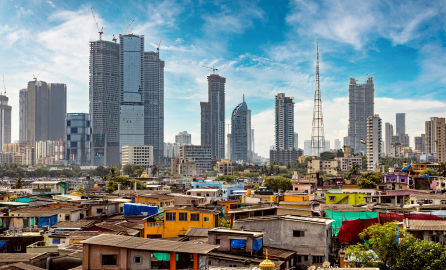How have inequalities evolved in recent years?
Regional Disparities
Since the onset of the COVID-19 pandemic, inequalities between countries have increased, reversing part of the progress made in previous decades. Regional disparities in income outcomes remain stark—and in many cases, are widening. The average monthly income in Sub-Saharan Africa remains just €240, compared to over €3,500 in North America and Oceania—a disparity of roughly 1 to 15. For comparison, the global average per capita national income (including the in-kind value of public services) is approximately €12,800 per year (PPP), or €1,065 per month.
Sub-Saharan Africa
Despite projected economic growth of 3.4% in 2024, Sub-Saharan Africa remains one of the most unequal regions globally. The richest 10% of the population earn 55% of total income, while the poorest 50% earn less than 10%. In particular, Southern Africa is a sub-region where two of the three most unequal countries in the world are found: South Africa and Namibia (with a Gini index of 63.4 and 59.1 respectively). These inequality gaps translate into deep regional divisions, with significant disparities in access to quality education, health services, infrastructure and gender equality. Such high inequality also undermines poverty reduction, as growth tends to benefit the wealthiest
Middle East and North Africa (MENA)
Income inequality in the MENA region remains persistently high, with Gini indexes ranging between 65 and 75 in several countries between 2015 and 2020. In addition, perceptions of well-being and economic security among middle-income groups have deteriorated over the last decade, partly as a consequence of the socio-political and economic instability that followed the Arab Spring. This is reflected in stagnating incomes, rising living costs, and declining trust in institutions. Key inequality drivers include barriers to equal opportunities in employment, unequal access to quality public services, stark urban‑rural divides, and entrenched horizontal disparities (notably in terms of ethnicity and religion).
Latin America
Latin America continues to be one of the most unequal regions, with a regional Gini coefficient of 49.9% in 2024. Several Latin American countries rank among the most unequal globally. For instance, Colombia had a Gini coefficient of 54.8% in 2022, placing it among the top three most unequal countries worldwide, following South Africa and Namibia. Other countries with high levels of inequality include Brazil, Panama, Guatemala, and Honduras, each with Gini coefficients exceeding 50%. Persistent issues include high informal labour and gender income disparities.
Asia
Asia exhibits diverse inequality trends. While some countries, like China (Gini Index of 48.0), have seen a sharp rise in inequality—where the richest 10% has increased sharply since the 1990s—other Asian economies show different patterns. For example, in Japan (Gini Index of 32.3) and South Korea (Gini Index of 32.9), inequality levels are relatively lower, thanks to stronger social protections and inclusive growth policies. In the Asia-Pacific region as a whole, the top 10% consistently control more than half of total income, while the income share of the bottom 50% has declined since 2000. Inclusive growth initiatives are underway, but challenges persist in addressing wealth concentration, especially in fast-growing economies where rapid urbanization and technological change can exacerbate disparities.
